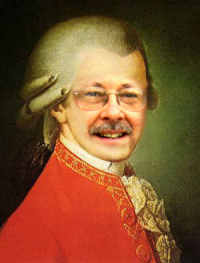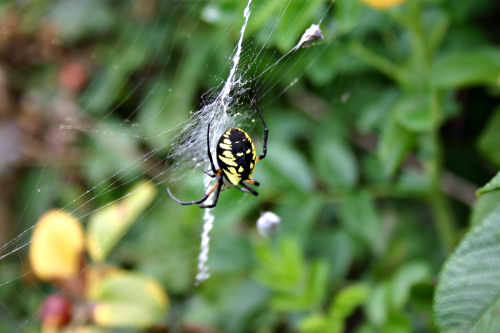A 365-Day Project
"We Are All Mozart"
A project to create
new works and change
the perception of the
music of our time.


 August 30, 2006
August 30, 2006 
Rub a little hot pepper in your eyes to keep them from glazing over. It's intellectual property time again, because today several items converged.
On Slashdot, my favorite geek site, there was a discussion entitled "A Working Economy Without DRM?," referring to Digital Rights Management -- technological barriers created to prevent the copying of media material. The second was discovering an unexpected performance of my Elusive Parallels (in Time) in Nebraska. The third was a reminder about the Creative Commons discussed on CNet. And finally, the other day I slipped the phrase "HeadOn. Apply directly to the forehead" into my commentary.
Composers by and large accept the idea of intellectual property. It provides the law's protection of their work, and they earn some income from it. As increasing income flows to artists from their efforts, they become committed to the concept without further consideration. Should they have misgivings, they are often loath to express them in the current divisive climate, where copyright owners scream "thief!" at file sharers and file sharers shout "greedy bastards!" at copyright owners. This environment is corrosive.
But first, a backstep to the items that converged.
The Slashdot article poses the question that is at the heart of the copyright frenzy at the outset of this century.
In economics, we learn that the price of a product is determined essentially by supply and demand. Without a DRM in place, we are capable of making as many copies of a piece of content as we want and seeding it onto the net. How do you create a market for a product, and make money of a product that has a huge initial creative investment, but then no manufacturing cost, and is in infinite supply?
Digital Rights Management is a technological answer to an apparent legal and social failure: that copying music and movies has become a simple fact of life, one significant enough to be noticed at the bottom line of media corporations. The late response of these corporations to a technological shift and their heavy-handed response in closing down Napster and KaZaa created an adversarial environment. Legally, they were right. Socially, they blew it. And because of that failure, they have adopted technological means to prevent copying, including close relationships with manufacturers to create hardware that will make copying music and movies impossible. Though most of the Slashdot community responses immediately devolved into simplistic arguments, one caught my attention (posted anonymously).
With the market, as with the law, your goal should be to make it easier to do what is right than to do what is wrong. If you do anything else, you encourage people to do wrong, and you reduce the level of respect for the 'wrong' distinction.
To the second item of convergence. My music is as much as possible made available in finished 'manufactured' form (as paper scores or on recordings) and in downloadable form (as PDF and MP3 files). I explain this on my website, and indeed hundreds of scores and musical examples are downloaded monthly. Nevertheless, I am surprised to learn of performances. Because performers are busy, they often forget to contact me about shows, so I self-google once a month or so to turn up performances. And sure enough, another one turned up, not only with a program, but with my own program notes (from the Vermont Contemporary Music Ensemble site) and even a link back to me. Nicely done.
The third element of the nexus is Creative Commons. This organization is only five years old, founded by several intellectual property experts to soften the terms of the debate by creating several new forms of licenses, including attribution, noncommercial, no derivate works, and 'share alike' versions. These licenses operate under the actual copyright ownership, but are non-revocable. They also make a list of "public domain dedications" -- works released entirely from copyright ahead of the present legal term.
And finally, HeadOn. For those who have never seen this commercial, it is marvelously disturbing. A dark-haired young woman looks heavenword with a smile of relief, rubbing a cylinder of some concoction on her forehead. The soundtrack repeats three times in an unabashed loop that sounds like an excerpt from a Catholic mass, "HeadOn. Apply directly to the forehead. HeadOn. Apply directly to the forehead. HeadOn. Apply directly to the forehead." This commercial has become perversely popular, appearing in original and parody form on YouTube and, as I discovered earlier today, making up part of a very recent performance by Tom Hamilton.
Each of these poses different kinds of solutions to the problem of increased virtualization of the products of the mind. The hammer approach of DRM will likely fail, if only because the collective destructive potential of losing access to a lifetime of music collection is present. Not only is the simple loss of data a looming crisis, but putting one's artistic purchases directly under corporate control is simply a bad idea.
My approach is a value-added one. The materials are made easily available by download or purchase. If the downloader does the work, then the cost goes down. If Westleaf Edition or Frog Peak Music do the work, then the cost goes up. The rest of the rights and royalties belong to the existing historical stream, paid as appropriate through licensing agences. Mine is ASCAP.
The Creative Commons is highly idealistic, but a palliative for those of astute ethical character and conviction that there is value in cultural growth beyond the financial. The Creative Commons licenses each create a contract to give up some rights owned by the creative artist in order to foster a more highly diverse community and keep the commons alive. Before Creative Commons existed, for example, my own computer articles from the 1980s were released to the public domain through a legal announcement. But it will take a notable entity -- one as elephantine as Disney -- to propel the Creative Commons licenses into more general use. Gambling on potential future income is addictive.
My quote and Hamilton's use fall under a slippery provision known as Fair Use. It's slippery because the copyright law in the U.S. calls it a limitation on the author's exclusive rights without a legally refined definition. My quote of the advertisement is likely fair use, though almost all of the advertisement's verbal content was quoted; Tom's audio quote of the advertisement falls closer to the concept of a sample, but not in a commercial setting. What the fourth estate calls a "chilling effect" settles like early autumn frost on the artists who must consider these issues. Even New Music Box ran down the topic once again.
So what are some of the implications? Let's assume that the majority of people buying iTunes for a buck each are doing it because they're upstanding, honest folk. Oh, wait, you're laughing. Try again. Let's assume that the majority of people buying iTunes for a buck each don't know how to get the stuff for free, which won't play on their iPod anyway because Apple happens to be a corporate intellectual property control freak. That's not it either. Try number three. Let's assume that the majority of people buying iTunes for a buck each are doing it because it's safe and convenient. There you are.
Which brings me back to the anonymous poster on Slashdot, whose comments closely parallel those made by Laurie Spiegel and me almost a decade ago. The anonymous poster wrote:
|
Witness Napster, Kazaa and other P2P software applications. They didn't win in the marketplace of people's time because they had legal issues; they won in spite of those issues. Look at how popular i-Tunes is. I-Tunes has a massive mark-up. I mean hell, you pay 75% or more of the same price required to support making and shipping and selling tons of plastic, without that overhead. And it has DRM, and lower quality than the CDs. If you had a music sales system where:
... why would you go to a P2P network without the administrative wherewithall to support that? Compare spending 99 cents and getting a song and a squishy happy feeling to not spending any money and getting who knows what, but definitely not the squishy feeling. |
And in 1997, we suggested that the future options would include:
|
If any reader has solutions to the intellectual property crisis as presented today and earlier, please write to me. The topic has been of serious interest since the debate on software copyright began and I interviewed a very young but copyright-fierce Bill Gates, who said to me, "there's nobody making money writing software."
* * *
I can no longer remember what I've written, so there's a new search box to the left. As well as these blogs, it will also bring up anything on my personal site.

A spider spins a web in the roses. Is there an analogy to the legal ramifications of intellectual property?